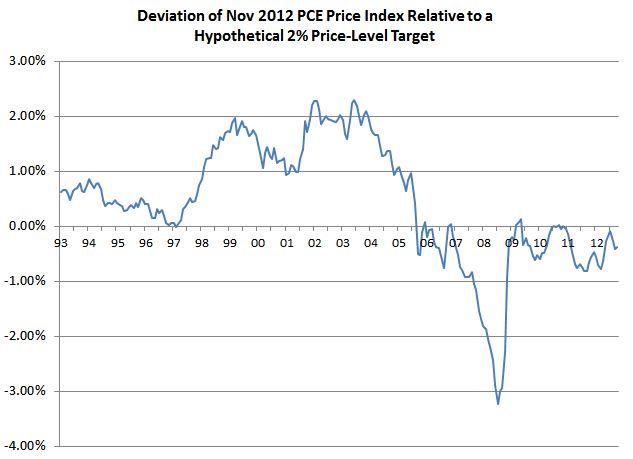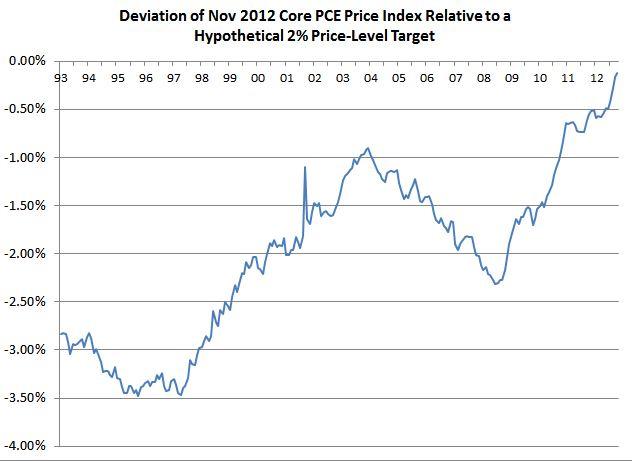(I could have put a "wonkish" warning at the top, but come on, just look at the title!)
Let's start with the concept of the natural real interest rate, which is already ubiquitous. The real interest-rate is the interest rate corrected for expected inflation, and the natural real interest rate is the real interest rate consistent with price stability. (I leave the definition of price stability ambiguous because it depends on your theory of the price level and inflation, which is a whole 'nother blog post.)
Now market monetarists like Scott Sumner and Nick Rowe point to a deficiency in the natural real interest rate concept: the natural real interest rate depends on the expected real growth rate. And monetary policy affects the expected real growth rate, so if policymakers try to set the actual interest rate equal to the natural rate, they are chasing a moving target. To me, this criticism suggests that the appropriate approach is to adjust the nominal interest rate not for expected inflation but for expected nominal growth. (While we're at it, we can also replace "price stability" with "nominal growth stability" and be done with our futile attempts to measure the aggregate price level.)
Most economists think that the natural real interest rate is normally positive. I have my doubts, but never mind, because I'm ditching the whole concept. Once we start correcting for expected normal growth rather than expected inflation, we are clearly not dealing with a natural rate concept that can be presumed to be normally positive. If we are talking about a risk-free interest rate, then the need for physical capital returns to compensate for risk would make it very hard to achieve a long-run growth rate [an equilibrium with the interest rate] as high as the [growth] interest rate, let alone higher. To come up with a number that's usually positive, I suggest that we reverse the sign. Instead of talking about a "natural growth-adjusted interest rate," let's talk about a "natural discounted growth rate."
We can also talk about an "actual discounted expected growth rate." (The discount is "actual," determined by the observable interest rate, but the associated growth rate is only "expected" because it is not known with any confidence when the interest rate is set.) If the actual rate equals the natural rate, you get a normal employment level and nominal income growth stability (or price stability, if you insist). If the actual rate is higher, you get accelerating inflation. If the natural rate is higher, you get depressed economic conditions, with excess unemployment and deflationary pressure, if not actual deflation. (Wicksellians, please recall that I have reversed the signs compared to the usual natural rate theory.)
Now that I've defined the natural discounted growth rate, I can define "secular stagnation" in the context of an NGDP target. Secular stagnation means that the natural discounted growth rate exceeds the growth rate of the NGDP target path. In other words, the target path would require a negative nominal interest rate. Under a level targeting regime, an attempt to pursue such a path will result in either monetary instrument instability or a "zigzag" growth pattern in which recessions alternate with inflationary catch-up periods. Under a growth rate targeting regime, you'll just keep missing the target from below, much like most of the developed world's central banks today.
But if you play with the numbers, you can probably convince yourself that secular stagnation, by my definition, seems unlikely. A reasonable NGDP target path growth rate is maybe 5%. Do we really think that the potential growth rate exceeds the natural interest rate by more than five percentage points? It's remotely conceivable, but my guess would be that our problem today is not secular stagnation (in this sense) but a flawed monetary policy regime.
Now if the target nominal growth rate (and the associated possibility of secular stagnation) is one of our bookends for the natural discounted growth rate, the other bookend is pretty clear: it's zero. Some readers will immediately recognize zero as the criterion for dynamic efficiency. Ignoring the issue of risk for a moment, an economy with a strictly positive natural discounted growth rate would be dynamically inefficient. Overall welfare could be improved by instituting a stable Ponzi scheme that transfers consumption backward across generations.
Does my assertion that the natural discounted growth rate is almost certainly strictly positive imply that we actually live in a dynamically inefficient economy? In an important sense, I think it does. The thorny issue here is risk, and some will argue that the relevant interest rate for dynamic inefficiency is not the risk-free rate. But I disagree. The US government can produce assets that are considered virtually risk free, and a stable Ponzi scheme operated by the US government could presumably produce such assets yielding any amount up to the growth rate. At today’s Treasury interest rates, which are clearly less than expected growth rates, marginal investors are (we can presume, since the assets are freely traded) indifferent between these low-yielding Treasury securities and investments that represent newly created capital. So, given the risk preferences of the marginal investor, the government could, by operating a stable Ponzi scheme, be producing assets that have a higher risk-adjusted return than newly created capital. Given the risk preferences of the marginal investor, it’s inefficient for the government not to be producing such assets.
It’s important to recognize that, under a typical scenario, the marginal investor will end up worse off, in a material sense, from earning the growth rate, compared to earning the actual return on capital. In a material sense, the economy is dynamically efficient. But the concept of risk preferences models a subjective good – call it “security” – and we’re not producing enough of this good. The history of interest rates and growth rates suggests that we have seldom produced enough security, but the deficiency today is clearly worse than usual.
DISCLOSURE: Through my investment and management role in a Treasury directional pooled investment vehicle and through my role as Chief Economist at Atlantic Asset Management, which generally manages fixed income portfolios for its clients, I have direct or indirect interests in various fixed income instruments, which may be impacted by the issues discussed herein. The views expressed herein are entirely my own opinions and may not represent the views of Atlantic Asset Management. This article should not be construed as investment advice, and is not an offer to participate in any investment strategy or product.



